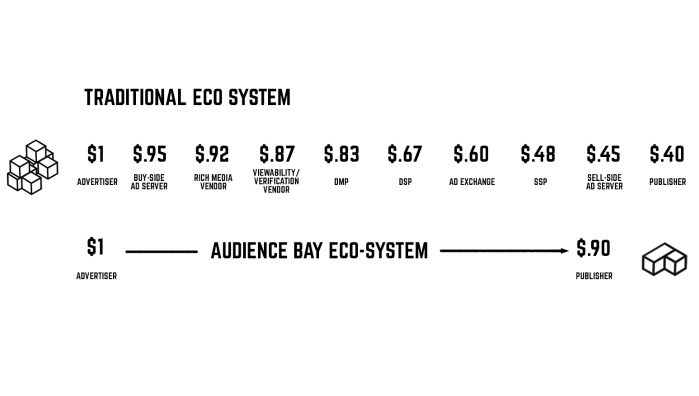The programmatic advertising platform addresses key challenges such as unaccountable supply chain, brand safety concerns, fake supply, bot traffic, user privacy infringement

The Audience Bay team
Programmatic advertising (which refers to the use of software to purchase digital advertising, as opposed to the traditional process that involves human negotiations and manual insertion orders) is becoming the preferred way for media buying across the world. In the US, over 80 per cent of media buying is done via programmatic, followed by the UK and Holland at over 50 per cent, along with many European and Asian countries.
However, with automation coming into an industry, which has traditionally worked on relationships, a lot of baggage has gotten accumulated over time. No existing technologies have been able to address the key challenges faced by this industry, including unaccountable supply chain, brand safety concerns, fake supply, bot traffic, user privacy infringement, and a diminishing trust from publishers and advertisers alike. This leads to disappearing dollar value for advertisers and publishers alike.
Can blockchain, one of the most-promising technologies of this decade, address this problem?
“Yes,” says Herat Maniar, Founder and CEO of Audience Bay, a startup which uses blockchain to eliminate frauds in the ads industry. “Blockchain is the most uncompromising technology for addressing frauds. Elimination of frauds will deliver better dollar value to advertisers and publishers.”
Incorporated in Singapore and headquartered in Gurgaon and Pune in India, AudienceBay has developed a programmatic platform for digital advertising, which it claims will bring transparency into the ecosystem.
Also Read: 4 ways blockchain will disrupt the traditional adtech ecosystem
“One of the biggest concerns for users is that their data can be misused by publishers or traded to third-party players without their consent. As of now, there is no mechanism to curb this misuse. The Audience Bay platform can effectively curb this, giving complete control to the user,” said Maniar.
How Audience Bay does this?
The startup, founded by Maniar and Varun Satyam (Chief Business Officer), has created a consent gateway, similar to cookie policy by websites. An ad publisher using the Audience Bay platform will be able to provide three options to the user — ‘to delete my data’, ‘where my data is used’ or ‘don’t use my data’. Here the publisher cannot use the data without his consent. “The data is recorded and stored on blockchain only if he/she gives explicit consent to use it. The user can then see whatever bidding is happening, or whatever ad is being served on his data. This way, we can effectively curb ad framing, such as cookie stuffing or click injections,” he elaborates.

Difference between the traditional platform and Audience Bay platform
According to Maniar, it is the ad publisher that gains the most from the platform. “Audience Bay eliminates the supply chain between the advertiser and publisher. In the current scenario, there are more than 18 players in between the advertiser and publisher. If one ad dollar is sent by the advertiser, it becomes just 40 cent by the time it reaches the publisher. But when an advertiser uses Audience Bay, they get 90 cent per dollar. Hence the maximum amount will go to the publisher,” he adds.
In technical terms, Audience Bay is into programatic advertisements where real time bidding (RTB) is a protocol. In programatic advertisements, when a user visits a publisher’s website, the request is sent to an ad exchange using RTB, where demand-side platform/advertisers will be bidding for users to show ads. All the transactions happening on the a exchange will be stored on blockchain.
Here the main difference is that the user can have a consent gateway, where he/she has the ability to delete his/her data that is stored with the publisher and he/she can ask for whomsoever is using his data. This will prevent illicit data trading as it is powered by blockchain. Since there is no place for hiding the cookies, there cannot be any ad fraud, such as cookie stuffing or click injections.
“Blockchain protects end users from being followed or his online behaviour being shared with unscrupulous digital advertisers. Blockchain also helps in fraud prevention by booting out bot clicks or non-human traffic coming across exchanges. Since the same user’s traffic is available across exchanges, the presence of different attributes of the same user leads to the algorithm identifying fraud traffic and then being exited from AudienceBay,” Maniar goes on.
Also Read: 3 ways blockchain platforms can make significant economic and social impact in Asia
Audience Bay is currently focussing on the European market, where user privacy is a key concern. Europe is implementing the General Data and Privacy Regulations on May 25, which will force all companies to improve their operational practices and uphold the right to privacy for users.

Audience Bay Founder and CEO Herat Maniar
“In India, we have been receiving interest from advertisers and publishers. However, India is a market where data privacy is not a key issue,” he says.
The startup charges US$0.01 per cost per thousand (CPM) for providing them with the infrastructure to monetise their inventory via other demand-side platforms (DSPs), exchanges and direct campaign from the advertiser, competing in real time to get the best value for their inventory.
Audience Bay, to be launches soon, plans to do a token sale to raise funds for building the product. “Since this is a blockchain-based product, we are looking to raise funds via token sales. In a later stage, we will look to raise funding from VC funds and accredited investors.
The post Blockchain startup Audience Bay aims to eliminate ad fraud and bring transparency into adtech industry appeared first on e27.